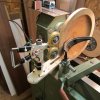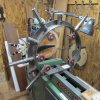Odie,
This maybe deserves a thread of its own. Don't want to hijack Robs thread .
Basically what you have done is let the wheels move a bit. This seems to me to be similar to the control I get by putting fingers behind the rim.
My fingers do a pretty good job of dampening the vibration.
Up to a point I feel there is a slight advantage to fingers in that the fingers to gouge maintain a constant distance so they move together on a slight warp
They fingers sort of act like calipers in a sense.
Your steady seems to have a couple of advantages. Fingers only give support for a few inches which is usually enough.
The second is woods like maple Burke with the spikes and inclusions are rough on the fingers.
Third is when working with a sharp rim you don't risk cutting your fingers.
Thanks for the tip,
I tried posting your photo here
Al
Hiya Al............

Yes, thank you, and you are certainly welcome. I believe you are absolutely correct that the wheels of a bowl steady are doing the same sort of thing as using your fingers to steady the workpiece. From my point of view, there is some amount of difference. The bowl steady is much more controllable, and allows you to use both hands for tool control.
Using the fingers is something I've used quite a bit, and still do on occasion. First choice would be to use a bowl steady, if that is within possibility. There are times when the shape of the bowl negates using the bowl steady, so fingers are always a final option.
No matter how much a bowl's moisture content is stabilized to the ambient atmosphere, as the wall thickness is reduced to the final thickness, there will nearly always be some degree of additional warp that occurs as a result of creating, or altering internal stresses in the wood itself. Theoretically, the bowl steady would be a perfect solution.....IF the host bowl remained a constant perfect circle, which it seldom does.....unfortunately, we woodturners don't live in that perfect world!
I have seen certain bowls that do not warp during final shaping to any detectable degree, but that is the exception to the rule. The rubber composition of the wheels used in the bowl steady have a certain amount of ability to move with the changing out of round conditions, but that can only go so far to preserve the stabilizing effect of the bowl steady. The spring allows for a little additional movement, and I find that very helpful. There comes a point with some bowls, where the warp becomes so pronounced, that a bowl steady is ineffective for it's purpose. At that point, if fingers don't do it, nothing will!

I can remember experimenting with the Oneway bowl steady when I first got it. The first tendency for me (and, I suspect.....others) is to increase the pressure of the wheels on the bowl when the steady was, or became ineffective for it's purpose. This exacerbates the problem because, in effect, what is happening is the wheels are attempting to alter the shape of the bowl back to perfect round......not good, because now you've got two separate forces that are attempting to alter the shape of the wood......the bowl steady, and your lathe tool's cutting action. The bowl steady works at peak performance with only a light wheel pressure to the bowl. The point is to avoid disrupting the shape of the bowl through the bowl steady, whether that shape be perfectly circular, or not. In other words, there comes a point where additional wheel pressure is worse than nothing at all. The spring allows the operator to increase the bowl steady's range of effectiveness, to a point. Once that point is reached, the bowl steady is no longer the best option.
Good idea about getting this on a separate thread........It was never my intention to go beyond that, but it became necessary to respond. My first post over there on Rob's thread should be clear evidence of that.
Thanks for listening, and hopefully all this makes some sense to a few of you, If so, my purpose in collecting my thoughts to compose this post won't be a total loss......

As someone once mentioned on this forum; To explain what you mean, your ideas, experiences and thoughts to someone else, is to further your own level of understanding. I believe that is very much true, and one of the great benefits of participating on this forum..........not to mention that I have benefited from other points of view, over and over again!

ooc


